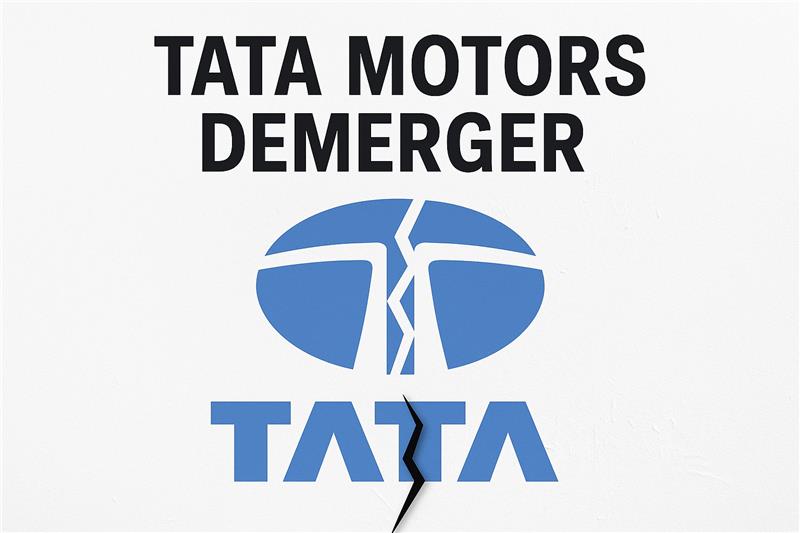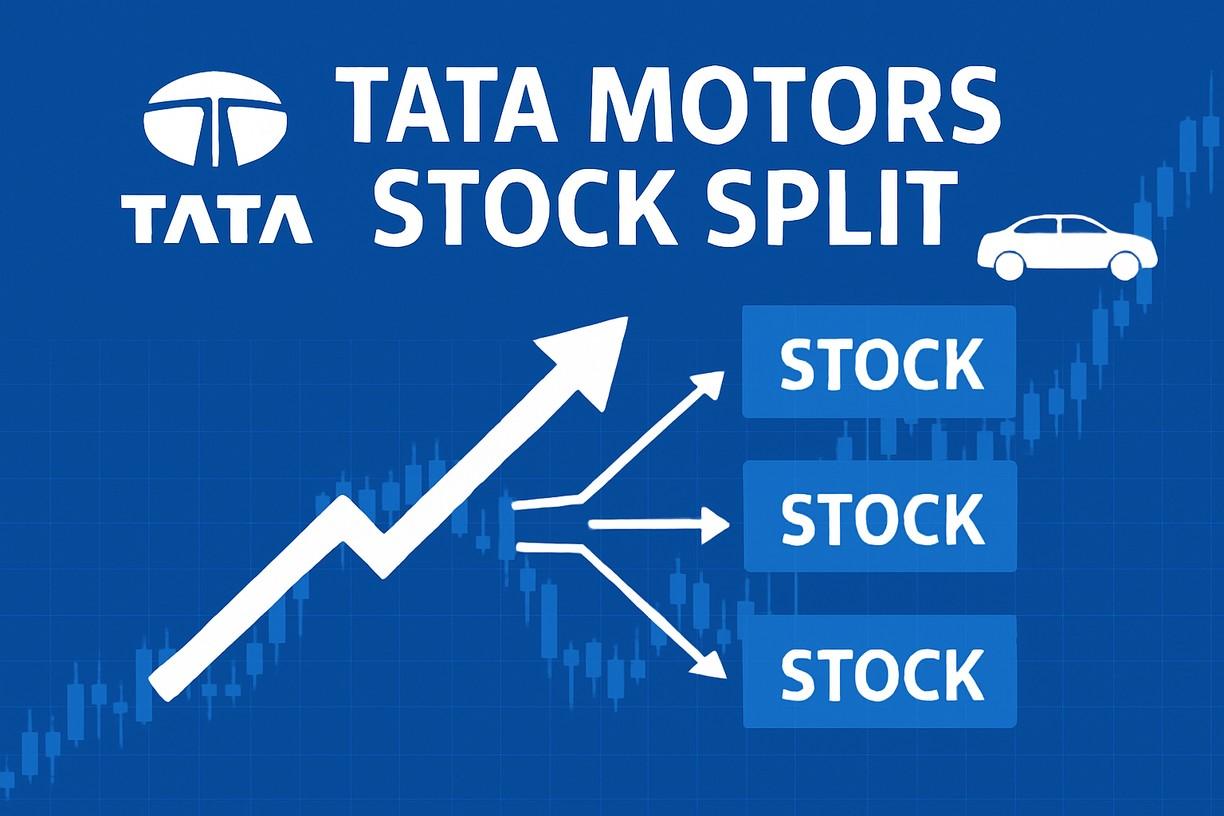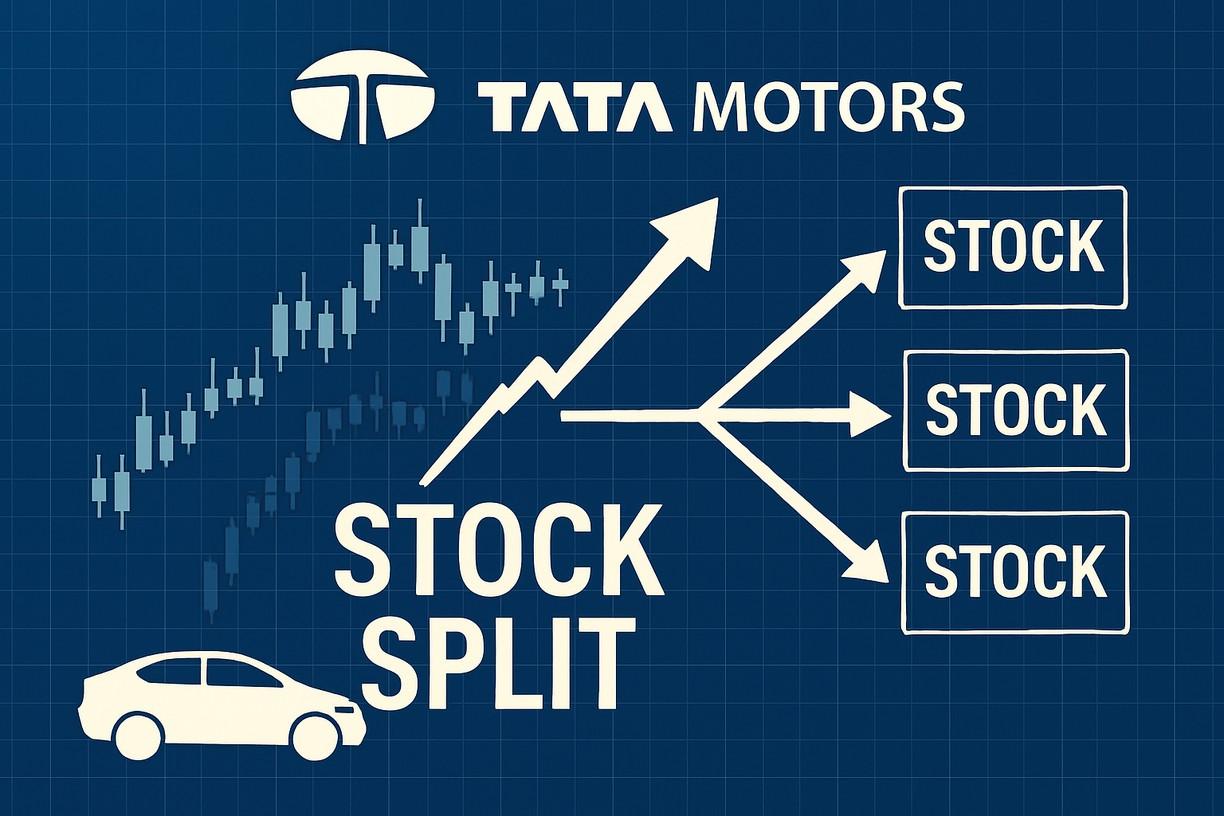On October 1, 2025, Tata Motors will officially demerge into two separately listed companies: a newly formed Commercial Vehicles (CV) company and the continuing Passenger Vehicles (PV) company, with a 1:1 share distribution (share entitlement) to existing Tata Motors shareholders.
Although sometimes labelled informally as a "stock split," this corporate action is legally a demerger (a business separation and share allotment), not a simple share subdivision. The company will allocate new shares in the CV company to existing shareholders under the approved scheme.
Shareholders overwhelmingly approved the scheme on May 6, 2025 (approval recorded at 99.9995% of votes), according to Tata Motors' exchange filings and media reports. [1]
Tata Motors Demerger: The Split and Its Purpose

In March 2024, Tata Motors announced a landmark restructuring to separate its operations into two distinct entities:
CM entity holding Commercial Vehicles and associated investments
PV entity retaining Passenger Vehicles, EVs, and Jaguar Land Rover
This strategic move aims to unlock value, enable a more focused operational approach, and attract more targeted investor interest.
On May 6, 2025, shareholders granted near-unanimous approval (99.9995%) for the demerger.
This strong mandate highlights investor confidence in Tata Motors' plan to separate its businesses for strategic clarity and growth potential.
Tata Motors Stock Split Date & Listing Timeline

The demerger becomes legally effective on October 1, 2025. By this date, the CV business will be spun off into a new listed entity, while the PV business will continue under the existing Tata Motors listing.
The final name of the CV company will be confirmed closer to the listing.
Operational completion, including share distribution and trading under separate tickers, is expected by Q2 FY26 (around March 2026).
What Is the Tata Motors Stock Split Share Swap Ratio?
Under the approved scheme, shareholders will receive one share in the new CV entity for each existing Tata Motors share (1:1 ratio).
Both entities will operate independently on NSE and BSE, offering investors the option to control their exposure.
The record date (determining shareholder eligibility) will be announced closer to execution. Trading will go ex-demerger post that date. [2]
What Is Tata Motors' Stock Split's Impact on Investors?

1) Strategic Clarity
Separating the business allows each arm, CV and PV, to pursue its tailored growth strategies and valuations, making it easier for investors to value the companies independently.
2) Enhanced Liquidity
Two different public entities may appeal to certain investor groups due to their commercial vs consumer orientation, potentially influencing trading dynamics and valuation transparency.
3) Market Signal
The stock price jumped in early 2025 upon announcement and has continued to outperform the Nifty Auto Index, indicating strong investor enthusiasm.
However, while data related to Tata Motors' restructuring is still developing, analysts expect initial volatility in the first 3–6 months after the listing, followed by clearer valuation separation.
Long-term returns will depend on individual segment performance and investor clarity.
Is Jaguar Land Rover Cyber Attack a Risk for Investors?

In late September 2025, a significant cyber incident affected Jaguar Land Rover, a key segment of the PV business, temporarily stopping production at factories in the UK and drawing the attention of the government and market. [3]
This operational interruption poses a short-term threat to the PV organisation that investors ought to watch closely.
What Investors Should Do Next?
1) Watch Official Announcements
Stay up-to-date on the record date and listing requirements that may influence your trading choices.
2) Reassess Investment
Consider whether you prefer exposure to the focused CV or PV segment, or both.
3) Track Market Response
Expect volatility around October 1, 2025, with possible opportunities emerging during the transition.
Post-Demerger Performance Watchlist (October 2025 and Beyond)
Once the demerger is executed on October 1, 2025, the market will begin pricing each entity, Commercial Vehicles (CV) and Passenger Vehicles + EV + Jaguar Land Rover (PV/EV/JLR), independently. Here are the key aspects investors should track:
1. Price Action & Valuation Split
Analysts expect the PV/EV/JLR entity to capture ~60% of Tata Motors' combined valuation, given the global EV push and JLR's premium positioning.
The CV entity is projected to hold ~40% of market capitalisation, trading closer to industrial peers.
Monitor NSE/BSE trading in the first 3–6 months, as volatility will likely be high.
2. Financial Results of Independent Entities
The first separate quarterly financials (Q3 FY26, January to March 2026) will be crucial in revealing revenue distribution, profit margins, and debt distribution.
Investors should compare the margins of PV/EV/JLR vs CV to see if the demerger is unlocking operational efficiency.
3. Dividend & Capital Allocation Policies
Expect each entity to announce its own dividend policy by mid-2026.
PV/EV/JLR may reinvest more heavily into electrification, while CV could emphasise steady dividends.
4. Institutional Ownership & Index Rebalancing
Watch for index adjustments (Nifty, Sensex, MSCI India), as global funds will rebalance their exposure to the new entities.
Post-demerger institutional purchases or sales might cause short-term fluctuations.
5. Global Comparisons
Similar auto-sector demergers (e.g., Daimler Trucks spin-off in 2021) experienced initial volatility followed by clear value unlocking. Investors should benchmark Tata's path against these global cases.
Frequently Asked Questions
1. When Is Tata Motors' Stock Split or Demerger Effective?
Tata Motors' demerger is officially effective from October 1, 2025.
2. Is Tata Motors' Demerger the Same as a Stock Split?
Not exactly. While often labelled a "stock split," the move is a demerger, separating Tata Motors into two independently listed businesses, rather than simply increasing the number of shares.
3. Has the Record Date for Tata Motors' Stock Split Been Announced?
As of September 2025, the record date has not yet been confirmed but is expected in late September 2025.
4. What Is the Share Swap Ratio for Tata Motors Shareholders?
Shareholders will receive shares in the new Commercial Vehicles entity on a 1:1 basis for every Tata Motors share they already hold. It means if you own 100 Tata Motors shares, you will get 100 shares in the new CV company, in addition to retaining your existing shares in the PV entity.
5. How Will Tata Motors' Demerger Affect Its Stock Price?
Following the demerger, Tata Motors' stock price will realign to indicate the split between CV and PV divisions.
Conclusion
In conclusion, Tata Motors' 2025 demerger marks a pivotal moment in the company's evolution. As of October 1, investors will transition into shareholders of two specialised, independently listed entities.
The move offers strategic clarity, liquidity benefits, and the potential for differentiated returns, presenting investors with a significant opportunity to reevaluate and adjust their investments in India's automotive industry.
Early analyst forecasts suggest PV + EV could account for ~60% of market capitalisation, while CV will represent approximatelty 40%. The success of this restructuring will depend on how each segment executes its growth strategy, making the post-demerger period a crucial watch point for long-term investors.
Disclaimer: This material is for general information purposes only and is not intended as (and should not be considered to be) financial, investment or other advice on which reliance should be placed. No opinion given in the material constitutes a recommendation by EBC or the author that any particular investment, security, transaction or investment strategy is suitable for any specific person.
Sources
[1] https://www.reuters.com/markets/emerging/indias-tata-motors-says-shareholders-approve-plan-split-automaker-2025-05-06/
[2] https://www.financialexpress.com/market/tata-motors-demerger-from-effective-date-to-final-timeline-5-must-know-details-3945244/
[3] https://www.reuters.com/world/uk/britain-considering-support-jaguar-land-rovers-suppliers-bbc-says-2025-09-25/























